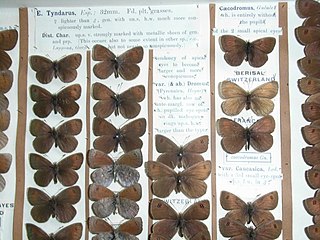
Papilio machaon, the Old World swallowtail, is a butterfly of the family Papilionidae. The butterfly is also known as the common yellow swallowtail or simply the swallowtail. It is the type species of the genus Papilio. This widespread species is found in much of the Palearctic and in North America.

Lycaena phlaeas, the small copper, American copper, or common copper, is a butterfly of the Lycaenids or gossamer-winged butterfly family. According to Guppy and Shepard (2001), its specific name phlaeas is said to be derived either from the Greek φλέγω (phlégo), "to burn up", or from the Latin floreo, "to flourish".

Erebia is a Holarctic genus of brush-footed butterflies, family Nymphalidae. Most of the about 90–100 species are dark brown or black in color, with reddish-brown to orange or more rarely yellowish wing blotches or bands. These usually bear black spots within, which sometimes have white center spots.

Erebia euryale, the large ringlet, is a species of butterfly belonging to the family Nymphalidae.

Erebia alberganus, the almond ringlet or almond-eyed ringlet, is a butterfly of the family Nymphalidae.

Erebia tyndarus, the Swiss brassy ringlet, is a European brush-footed butterfly species of the subfamily Satyrinae.

The brassy ringlets are a species group of ringlet butterflies in the genus Erebia. Though closely related, their monophyly is not completely resolved. Still, the brassy ringlets are taxa similar to E. tyndarus – the Swiss brassy ringlet –, and in many cases certainly close relatives. A notable trait of their genus is an ability to adapt well to cold and somewhat arid habitat, like taiga or regions with alpine climate. Optimal habitat in Eurasia, where most of the brassy ringlets are found, therefore occurs in two distinct belts – in the very north of the continent and in the Alpide belt – in interglacials, and in glacials in one periglacialic belt at lower altitude, in places interrupted by dry wasteland and deserts.

Oeneis jutta, the Jutta Arctic or Baltic grayling, is a species of butterfly in the subfamily Satyrinae with a Circumboreal distribution. It occurs in bogs and tundra in the north of Europe, the Baltic states, the Urals, Siberia, northern Kazakhstan, the Russian Far East, northern Mongolia, northeastern China, North Korea, and northern North America. Larvae feed on Carex and Eriophorum, possibly also Glyceria, Molinia, and Juncus. Ledum palustre is the preferred nectar plant of the adult butterflies. The species has one generation every one or two years, depending on the location.

Oeneis melissa, the Melissa Arctic, is a species of butterfly in the family Nymphalidae.

Oeneis bore, the white-veined Arctic or Arctic grayling, is a butterfly, a species of Satyrinae that occurs in North America and Asia.

Erebia vidleri, the northwest alpine or Vidler's alpine, is butterfly belonging to the subfamily Satyrinae of the family Nymphalidae. It is found in western North America.

Erebia rossii, the Arctic alpine or Ross's alpine, is a member of the subfamily Satyrinae of the family Nymphalidae. It is found in Arctic North America and northern Eurasia.
Erebia anyuica, the scree alpine, is a member of the subfamily Satyrinae of family Nymphalidae. It is found in Siberia, in several isolated areas of Alaska, and in a band that extends across northern Alaska and northern Yukon to the Richardson Mountains on the Yukon/Northwest Territories border.
Erebia pawloskii, commonly known as the yellow-dotted alpine, is a member of the subfamily Satyrinae of the family Nymphalidae. It is found in North America in northern British Columbia, Yukon, and Alaska. It is also found in the Sayan Mountains, and from northern Mongolia to Yakutia and Kamchatka. The habitat consists of grassy areas in and above wet tundra, as well as bogs.

Erebia discoidalis, the red-disked alpine, is a member of the subfamily Satyrinae of family Nymphalidae. It is found in North America from eastern Quebec, through northern Ontario, and the northern Prairies to northern British Columbia, the Northwest Territories, Yukon, and Alaska. It reaches just into the northern U.S. between Michigan and Montana, and also occurs in Asia, where it has been recorded from the Chukot Peninsula to the eastern Sayan Mountains and Amur. The habitat consists of large, open, grassy bogs and other areas with acidic soils.
The Magdalena alpine is a member of the subfamily Satyrinae of the family Nymphalidae. It is found in North America from Montana, Colorado, Utah, and New Mexico, and in Canada in a small part of the Willmore Wilderness Park, Alberta, and adjacent British Columbia, in Stone Mountain Provincial Park in northern British Columbia, and on an isolated nunatak in Kluane National Park and Reserve, Yukon. The habitat consists of rockslides near vegetation, at or above the treeline.
Erebia mancinus, the taiga alpine, is a member of the subfamily Satyrinae of the family Nymphalidae. It lives in subarctic North America from Labrador, northern Quebec, and northern Ontario, through the northern Prairie Provinces, northern British Columbia, and the interior of the Northwest Territories to Yukon and Alaska. It also ranges south in the mountains as far as Banff, Alberta. The habitat consists of black spruce-sphagnum bogs.














